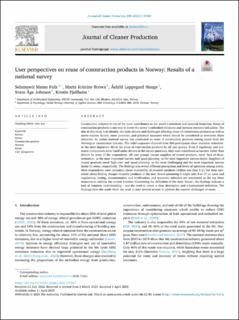| dc.contributor.author | Fufa, Selamawit Mamo | |
| dc.contributor.author | Henriksen, Marin Kristine | |
| dc.contributor.author | Hauge, Åshild Lappegard | |
| dc.contributor.author | Johnsen, Svein Åge Kjøs | |
| dc.contributor.author | Fjellheim, Kristin | |
| dc.date.accessioned | 2023-04-27T05:52:50Z | |
| dc.date.available | 2023-04-27T05:52:50Z | |
| dc.date.created | 2023-04-14T07:25:18Z | |
| dc.date.issued | 2023 | |
| dc.identifier.issn | 0959-6526 | |
| dc.identifier.uri | https://hdl.handle.net/11250/3065186 | |
| dc.description.abstract | Construction industry is one of the main contributors to the world's emissions and material footprints. Reuse of construction products is one way to lower the sector's embodied emissions and increase resource utilisation. The aim of this study is to identify the main drivers and challenges affecting reuse of construction products as well as assess success factors, reuse potential, and potential measures which should be considered to overcome these obstacles. An online national survey was conducted on reuse of construction products among actors from the Norwegian construction industry. The valid responses obtained from 260 participants show ‘emission reduction’ as the most important driver for reuse of construction products by all user groups. Even if regulatory and economic components were listed under drivers in the survey questions, they were considered as barriers rather than drivers by some of the respondents. All user groups, except suppliers of reused products, rated ‘lack of documentation’ as the most important barrier, and ‘good planning’ as the most important success factor. Suppliers of reused products rated ‘high cost’ and ‘good planning’ as the most challenging and the most important success factor for reuse, respectively. The findings also reveal different perceptions and levels of optimism among actors. Most respondents were optimistic about availability of reusable products (within less than 5 y), but least optimistic about finding cheaper reusable products in the near future (assuming it might take 9 to 17 y). Laws and regulations, testing, documentation and certification, and economic subsidies are mentioned as the top three measures to address the current barriers. Concerning the definition of the term ‘Reuse’, the findings indicate a lack of common understanding – and the need to create a clear description and a harmonised definition. The findings from the study show the need to take several actions to address the current challenges of reuse. | en_US |
| dc.language.iso | eng | en_US |
| dc.publisher | Elsevier | en_US |
| dc.rights | CC BY 4.0 | * |
| dc.rights.uri | http://creativecommons.org/licenses/by/4.0/ | * |
| dc.subject | Barrier | en_US |
| dc.subject | Driver | en_US |
| dc.subject | Construction product | en_US |
| dc.subject | Norway | en_US |
| dc.subject | Reuse | en_US |
| dc.subject | User perspective | en_US |
| dc.title | User perspectives on reuse of construction products in Norway: Results of a national survey | en_US |
| dc.type | Peer reviewed | en_US |
| dc.type | Journal article | en_US |
| dc.description.version | publishedVersion | en_US |
| dc.rights.holder | © 2023 The authors | en_US |
| dc.subject.nsi | VDP::Teknologi: 500 | en_US |
| dc.source.volume | 408 | en_US |
| dc.source.journal | Journal of Cleaner Production | en_US |
| dc.identifier.doi | 10.1016/j.jclepro.2023.137067 | |
| dc.identifier.cristin | 2140743 | |
| dc.relation.project | Norges forskningsråd: 302754 | en_US |
| dc.source.articlenumber | 137067 | en_US |
| cristin.ispublished | true | |
| cristin.fulltext | original | |
| cristin.qualitycode | 2 | |

